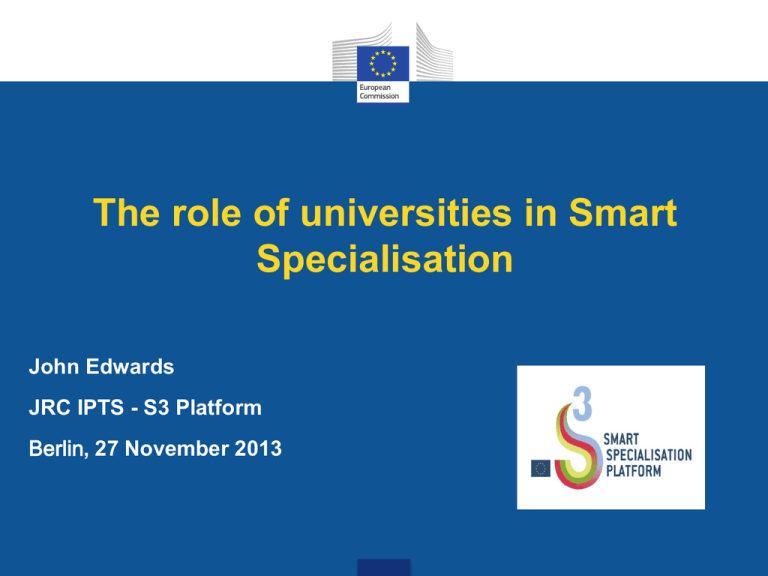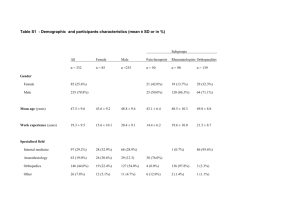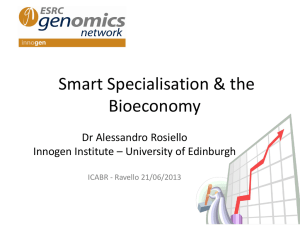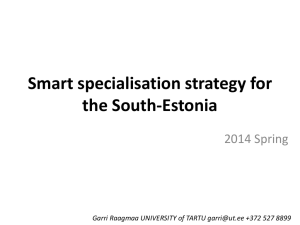What is Smart Specialisation
advertisement

The role of universities in Smart
Specialisation
John Edwards
JRC IPTS - S3 Platform
Berlin, 27 November 2013
Context of 2014-2020 funding cycle
• Europe's challenges:
• Lack of economic growth following economic and financial crisis
• Increasing imbalances across the continent (and within many
countries)
• High social costs of austerity and declining public confidence
• Increased competition from other parts of the world
Context of 2014-2020 funding cycle
• Europe's responses:
• Sound public finances
• Structural reforms – restoring competitiveness (e.g. more flexible
labour markets, completing of the single market)
• Smart consolidation – protect pro-growth budgets
• Innovation to compete globally and tackle social and
environmental challenges (Europe 2020)
Investment in R&D is part of the solution
to exit from the economic crises
Is there a link between innovation and regional growth?
“The general consensus…is that the driving force behind long-term economic growth is science, technology and
innovation in its different forms and facets” (OECD 2011: Regions and Innovation Policy)
70
Index of economic output
60
50
40
30
20
10
0
0
10
20
30
40
50
60
70
Index of innovative output
Source: Mikel Navarro et al, Basque Competitiveness Institute 2010.
"Until the 1980s, technology and innovation were under recognised influences in the explanation of differences in the rates of
economic growth between regions in advanced industrial nations..." (Townroe)
Innovation Union for Europe
• One of seven flagship initiatives of
Europe 2020
• Aim is to create the best conditions
('ecosystem') for researchers and
entrepreneurs to innovate
• A broad approach to innovation (not
just high tech, also product, service,
social, public sector, eco)
• 34 commitments – 24 & 25 concern
structural funds and smart
specialisation
"Smart Specialisation is a strategic approach to economic development
through targeted support to Research and Innovation"
What is Smart Specialisation ?
= evidence-based: all assets
= no top-down decision, but
dynamic/entrepreneurial
discovery process inv. key
stakeholders
= global perspective on potential
competitive advantage &
potential for cooperation
= source-in knowledge and
technologies etc. rather than
re-inventing the wheel
= priority setting in times of scarce
resources
= getting better / excel with
something specific
= focus investments on regional
comparative advantage
= accumulation of critical mass
= not necessarily focus on a single
sector, but cross-fertilisations
In a nutshell:
Smart Specialisation is based on 4 Cs
Competitive advantage: match R&I with business and develop links
(related variety); adoption of (generic/new) technologies for
diversification/modernisation of sectors + explore emerging areas
Policy Choices (tough ones): select few priorities on basis of
specialisation & integration in international value chains
Critical mass of resources & talent: cooperation between regions by
avoiding duplication and fragmentation
Collaborative Leadership: involve stakeholders from academia,
businesses, public administrations and civil society ("quadruple helix")
& synergies between funding instruments (EU, national, regional)
The evolution of Smart Specialisation
Expert workshop in Barcelona,
organised by JRC-IPTS
JRC Scientific and Technical Reports, 2009: « The
question of R&D specialisation – Perspectives and
policy implications »
“Knowledge for Growth expert group” launched
the concept in the framework of ERA (2009)
The concept is incorporated in the Europe 2020
agenda as part of the Innovation Union flagship
initiative (2010)
EC Communication « Regional policy contributing
to smart growth in Europe 2020 » - smart
specialisation as a key concept for the EU regional
and cohesion policy 2014-2020
EC proposes S3 as a 'thematic ex-ante
conditionality' for R&I spending under ERDF
S3 Platform is established at JRC-IPTS (2011)
June
2008,
How to develop a S3?
Analysis
Process
Monitoring
RIS3
Policy mix
Vision
Priorities
Why should universities care about
smart specialisation?
• Increasing concern about social and economic impact of publicly
funded universities (e.g. ranking and funding; U-multi rank, UK
REF, Austira Leistungsvereinbarungen, Spain – Aneca)
• Large amount of European Structural and Investment Funds
linked to smart specialisation
• Opportunity to build partnerships with local and regional
authorities for mutual benefit
• Synergies between support for R&I through the structural funds
and European / national competitive financing will determine the
overall funding structure
Cohesion
Policy funding
for R&I
2007-2013
Cohesion Policy
innovation support over
total aid:
4% in 89’-93’
7% in 94’-99’
11% in 00’-06’
25% in 07’-13’
Cohesion policy - planned investment by major
investment fields - 2007-2013 (in € billions)
see: http://ec.europa.eu/regional_policy/sources/docgener/studies/pdf/cp_employ_growth_en.pdf
ERDF 2014-20: Concentration on R&I, ICTs
and SMEs to maximise impact
* At least two of four
themes must be selected
Research and Innovation
Access and use of ICTs
SMEs competitiveness
Energy efficiency and renewable energy (compulsory)
38% *
45% *
60% *
20%
15%
Developed regions
Transition regions
Cohesion
Policy
12%
Less developed regions
(plus island and outermost regions)
Billion
EUR
Less developed regions
164.3
Transition regions
31.7
More developed regions
49.5
Cohesion Fund
66.4
European territorial cooperation
8.9
Of which
Cross border cooperation
6.6
Transnational cooperation
1.8
Interregional cooperation
0.5
Outermost regions and
northern sparsely populated
regions
1.4
Youth Employment initiative
3.0
TOTAL
325.1
Investment Priority 1
Council modifications
(1) strengthening research, technological development and innovation:
(a) enhancing research and innovation (R&I) infrastructure […] and capacities to
develop R&I excellence and promoting centres of competence, in particular those
of European interest;
(b) promoting business […] investment in innovation and research, and
developing links and synergies between enterprises, R&D centres and higher
education, in particular product and service development, technology transfer,
social innovation and public service applications, demand stimulation,
networking, clusters and open innovation through smart specialisation […]
supporting technological and applied research, pilot lines, early product validation
actions, advanced manufacturing capabilities and first production in Key Enabling
Technologies and diffusion of general purpose technologies;*
*) ICT, photonics, nano-electonics, nano- and bio-technologies, advanced materials, etc..
Cohesion
Policy
An Agenda for Modernisation of Europe’s
Higher Education System (COM (2011) 567)
• ‘In assessing the role of HEIs in the region it is useful to
identify the steps needed to create a ‘connected region’ in
which the institutions are key players. Through this
connection process institutions become key partners for
regional authorities in formulating and implementing their
smart specialisation strategies’
• ‘They can contribute to a region’s assessment of its
knowledge assets, capabilities and competencies, including
those embedded in the institution’s own departments as
well as local businesses, with a view to identifying the most
promising areas of specialisation for the region, but also the
weaknesses that hamper innovation’
Contribution of universities to S3
Generative
Research related (but not limited)
to regional priorities
Multi- and cross- disciplinary
Connectivity – knowledge nodes
Absorptive
Help build capacity to ensure local
firms absorb knowledge
Provide demand through teaching
and learning activities
Nurture social ties that drive RIS
Support regional analysis
Collaborative
Leadership
Neutral regional brokers
Support regional vision and
partnership
Reach Out – need 'boundary
spanners'
Reach In – Co-production of
knowledge
Propose joint activities
Place marketing
Source: Based on Kempton et al (2013) Universities and Smart Specialisation, JRC S3 Policy Brief #3, European Commission
The
PUBLIC SECTOR
‘disconnected’
Lack of coherence between national
region
and regional/local policies
Lack of political leadership
Lack of a shared voice and vision at
the regional/local level
HIGHER EDUCATION SECTOR
Seen as ‘in’ the region but not
‘of’ the region
Policies and practices
discourage engagement
Source: Goddard, J
and Kempton, L
(2011) Connecting
Universities to
Regional Growth,
European Commission
Focus on rewards for
academic research and
teaching
PRIVATE SECTOR
No coordination or representative
voice with which to engage
Motivated by narrow self interest
and short term goals
No boundary spanners
Dominated by firms with low
demand or absorptive capacity
for innovation
Focus on supply side, transactional
interventions
Ineffective or non existent
partnership
Lack of a shared understanding
about the challenges
Entrepreneurs ‘locked out’ of
regional planning
The ‘connected’
region
PUBLIC SECTOR
Developing coherent policies
that link territorial development
to innovation and higher
education
Strong partnerships
based on shared
understanding of the
barriers and how to
overcome them
Evidence based
policies that
support ‘smart’
innovation
and growth
Generating intellectual and
human capital assets for the
region
Source: Goddard, J
and Kempton, L
(2011) Connecting
Universities to
Regional Growth,
European Commission
HIGHER EDUCATION
SECTOR
Investing in people and ideas
that will create growth
PRIVATE SECTOR
Business
manufacturing and
services, primary sectors,
financial sector, creative
industries, social sector,
large firms, SMEs,
young entrepreneurs,
students with business
ideas, cluster and business
organisations,
if relevant at different
government levels,
agencies e.g. for regional
development,
business advice,
public procurement
offices, incubators, etc.
Public
administration
Research
& education
public and private
research bodies,
universities, education
and training,
science and
technology parks,
Technology transfer
offices, etc.
NGOs and citizens’
initiatives related to
societal challenges for
which innovative
solutions would be
helpful, consumers
associations,
Talents! etc.
Civil society /
Users
How to start
entrepreneurial
discovery process
Kick-start with consultation in
quadruple helix:
Detect potential boundaryspanners between different
stakeholder / interest groups,
new innovative
entrepreneurs, hidden
champions, or persons with a
potential for this is one of the
aims of this first step. …
See new annex III of RIS3 Guide
Horizon 2020 and Cohesion Policy:
Differences and complementary objectives
EU R&D and Innovation Policy –
future Horizon 2020
EU Cohesion Policy
Differences
Based largely on individual R&D and innovation projects of a
pre-competitive nature aiming at advancing knowledge and
fostering innovation for growth and jobs, including but not
exclusively frontier research (also co-funding national and
regional programmes)
Based on multiannual programmes aiming at increased to
reduce regional disparities, including through close to the
market competitive R&D and innovation efforts
Awarded directly to final beneficiaries (firms, public and private
R&D centres and Universities, including national and regional
governments in certain cases – Art. 185, ERA-NET etc.)
Awarded through shared management exclusively to national
and regional public intermediaries
Through transnational competitive calls addressed to
international groupings through peer review based on
excellence criteria
Non competitive attribution addressed to regional players
based on strategic planning negotiation (however calls possible
at national or regional level)
Synergies and Complementarities
Horizon 2020 will focus on tackling major societal challenges,
maximising the competitiveness impact of research and
innovation (Industrial leadership) and raising and spreading
levels of excellence in the research base
Cohesion policy will focus on galvanising smart specialisation
that will act as a capacity building instrument, based on learning
mechanisms and the creation of critical skills in regions and
Member States.
134 EU regions
+ 11 EU countries
+ 2 non-EU
regions
NEW!
Benchmarking and
targeted support
Transantional
Cooperaion
Interactive tools,
S3 Newsletter
and Website
Country- and Macro-region
events and targeted
seminars at IPTS
Research and
analysis
Extra support for
digital agenda and
ICT sections of RIS3
Methodological
Guidance
Peer Review
workshops & transnational learning
Thematic
workshops &
working groups
RIS3 assessment
and support to REGIO
desks
Universities and the S3 Platform
Working with the European University
Association
Two day workshop in Seville, February 2013
Open Days workshop in October 2013 together
with DG Education and Culture
More activities in 2014, including high level
conference in Brussels (June tbc)
Find out more:
http://s3platform.jrc.ec.europa.eu/universities
Thank you!
http://s3platform.jrc.ec.europa.eu
JRC-IPTS-S3PLATFORM@ec.europa.eu




![[I-2] Mahr](http://s2.studylib.net/store/data/005533114_2-575c16bb39129d77e4fc404ccab7077e-300x300.png)